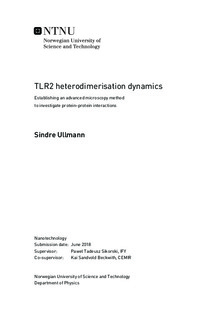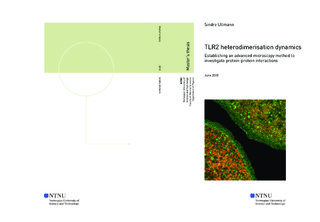| dc.description.abstract | In the work presented in this thesis a method for measuring the lifetime of intrinsically expressed fluorescent proteins in live cells has been demonstrated and optimised. A set of THP-1 cell lines, designed by way of viral transduction, have been employed towards investigating TLR2 heterodimerisation dynamics. Confocal laser scanning and total internal reflection microscopy has been utilised on live cells to characterise cell lines expressing fluorescent proteins mNeonGreen (mNG) and mScarletI (mScI) on Toll-like receptors (TLRs) 1, 2 and 6. TLR2 was as expected found on the outer cell membrane, TLR1 unexpectedly resided mainly on the endoplasmic reticulum, while the results on TLR6 were inconclusive.
For measuring the instrument response function of the fluorescence lifetime microscopy system a solution of Fluorescein quenched by iodide ions at saturation has been employed. Fluorescence lifetimes for mNG and Coumarin 6, a calibration sample, were measured and correspond well with values from the literature. Fluorescence lifetime measurements were used towards detecting Förster resonance energy transfer (FRET) between the fluorescent proteins expressed on the TLRs upon them forming heterodimers. Cells were stimulated both with TLR ligands in solution and microbeads covered with ligands. FRET was however not detected in the TLR reporter cell lines, but could meanwhile be demonstrated in a positive FRET control cell line where the FRET pair mNG (donor) and mScI (acceptor) were linked together and expressed freely in the cytosol of the cells. During this work an issue with the microscope was observed which was attributed to a reflection from the excitation laser reaching the detectors.
The Introduction and Theory chapter presents the reader the motivation for this project, namely tuberculosis and TLRs important role in the host-pathogen interactions between the human immune system and the deadly bacteria Mycobacterium tuberculosis. Then the background is explained, by performing a review of relevant literature, both the current status of the research field and previous endeavours relevant for this project. The required knowledge of the employed microscopy techniques utilised are introduced, before the materials, methods and results are further presented, discussed and compared to relevant literature before futures prospects for the method are presented and closing conclusions are offered.
We believe that this system may be applied in research not only on TLR heterodimerisation, with some additional future work, but also in endeavours towards investigating completely different scientific topics. | |

